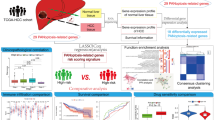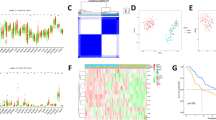Abstract
PANoptosis is a form of inflammatory programmed cell death that is regulated by the PANoptosome. This PANoptosis possesses key characteristics of pyroptosis, apoptosis, and necroptosis, yet cannot be fully explained by any of these cell death modes. The unique nature of this cell death mechanism has garnered significant interest. However, the specific role of PANoptosis-associated features in gastric cancer (GC) is still uncertain. Patients were categorized into different PAN subtypes based on the expression of genes related to the PANoptosome. We conducted a systematic analysis to investigate the variations in prognosis and tumor microenvironment (TME) among these subtypes. Furthermore, we developed a risk score, called PANoptosis-related risk score (PANS), which is constructed from genes associated with the PANoptosis. We comprehensively analyzed the correlation between PANS and GC prognosis, TME, immunotherapy efficacy and chemotherapeutic drug sensitivity. Additionally, we performed in vitro experiments to validate the impact of Keratin 7 (KRT7) on GC. We identified two PAN subtypes (PANcluster A and B). PANoptosome genes were highly expressed in PANcluster A. PANcluster A has the characteristics of favorable prognosis, abundant infiltration of anti-tumor lymphocytes, and sensitivity to immunotherapy, thus it was categorized as an immune-inflammatory type. Meanwhile, our constructed PANS can effectively predict the prognosis and immune efficacy of GC. Patients with low PANS have a good prognosis, and have the characteristics of high tumor mutation load (TMB), high microsatellite instability (MSI), low tumor purity and sensitivity to immunotherapy. In addition, PANS can also identify suitable populations for different chemotherapy drugs. Finally, we confirmed that KRT7 is highly expressed in GC. Knocking down the expression of KRT7 significantly weakens the proliferation and migration abilities of GC cells. The models based on PANoptosis signature help to identify the TME features of GC and can effectively predict the prognosis and immune efficacy of GC. Furthermore, the experimental verification results of KRT7 provide theoretical support for anti-tumor treatment.









Similar content being viewed by others
Data availability
The datasets analyzed during the current study are available at TCGA-STAD (GDC (cancer.gov)), GSE84437 (GEO Accession viewer (nih.gov)) and Supplementary Materials.
Abbreviations
- PCD:
-
Programmed cell death
- GC:
-
Gastric cancer
- TME:
-
Tumor microenvironment
- PANS:
-
PANoptosis-related risk score
- KRT7 :
-
Keratin 7
- TMB:
-
Tumor mutation burden
- MSI:
-
Microsatellite instability
- ICIs:
-
Immune checkpoint inhibitors
- TCGA:
-
The cancer genome atlas
- GEO:
-
Gene expression omnibus
- GSVA:
-
Gene set variation analysis
- ssGSEA:
-
Single-sample gene set enrichment analysis
- ICPs:
-
Immune checkpoints
- HLA:
-
Human leukocyte antigen
- DEGs:
-
Differentially expressed genes
- OS:
-
Overall survival time
- TIDE:
-
Tumor immune dysfunction and exclusion
- EDU:
-
5-Ethynyl-2′-deoxyuridine
References
Bray F, Ferlay J, Soerjomataram I, Siegel RL, Torre LA, Jemal A (2018) Global cancer statistics 2018: globocan estimates of incidence and mortality worldwide for 36 cancers in 185 countries. CA Cancer J Clin 68(6):394–424. https://doi.org/10.3322/caac.21492
Hahn KY, Park CH, Lee YK, Chung H, Park JC, Shin SK et al (2018) Comparative study between endoscopic submucosal dissection and surgery in patients with early gastric cancer. Surg Endosc 32(1):73–86. https://doi.org/10.1007/s00464-017-5640-8
Japanese Gastric Cancer Association (2021) Japanese gastric cancer treatment guidelines 2018 (5th edition). Gastric Cancer 24(1):1–21. https://doi.org/10.1007/s10120-020-01042-y
Wei L, Sun J, Zhang N, Zheng Y, Wang X, Lv L et al (2020) Noncoding Rnas in gastric cancer: implications for drug resistance. Mol Cancer 19(1):62. https://doi.org/10.1186/s12943-020-01185-7
Chalabi M, Fanchi LF, Dijkstra KK, Van den Berg JG, Aalbers AG, Sikorska K et al (2020) Neoadjuvant immunotherapy leads to pathological responses in Mmr-proficient and Mmr-deficient early-stage colon cancers. Nat Med 26(4):566–576. https://doi.org/10.1038/s41591-020-0805-8
Sheih A, Voillet V, Hanafi LA, DeBerg HA, Yajima M, Hawkins R et al (2020) Clonal kinetics and single-cell transcriptional profiling of car-T cells in patients undergoing Cd19 car-T immunotherapy. Nat Commun 11(1):219. https://doi.org/10.1038/s41467-019-13880-1
Sharma P, Hu-Lieskovan S, Wargo JA, Ribas A (2017) Primary, adaptive, and acquired resistance to cancer immunotherapy. Cell 168(4):707–723. https://doi.org/10.1016/j.cell.2017.01.017
Hänggi K, Ruffell B (2023) Cell death, therapeutics, and the immune response in cancer. Trends Cancer 9(5):381–396. https://doi.org/10.1016/j.trecan.2023.02.001
Tong X, Tang R, Xiao M, Xu J, Wang W, Zhang B et al (2022) Targeting cell death pathways for cancer therapy: recent developments in necroptosis, pyroptosis, ferroptosis, and cuproptosis research. J Hematol Oncol 15(1):174. https://doi.org/10.1186/s13045-022-01392-3
Bertheloot D, Latz E, Franklin BS (2021) Necroptosis, pyroptosis and apoptosis: an intricate game of cell death. Cell Mol Immunol 18(5):1106–1121. https://doi.org/10.1038/s41423-020-00630-3
Samir P, Malireddi RKS, Kanneganti TD (2020) The panoptosome: a deadly protein complex driving pyroptosis, apoptosis, and necroptosis (Panoptosis). Front Cell Infect Microbiol 10:238. https://doi.org/10.3389/fcimb.2020.00238
Christgen S, Zheng M, Kesavardhana S, Karki R, Malireddi RKS, Banoth B et al (2020) Identification of the panoptosome: a molecular platform triggering pyroptosis, apoptosis, and necroptosis (Panoptosis). Front Cell Infect Microbiol 10:237. https://doi.org/10.3389/fcimb.2020.00237
Place DE, Lee S, Kanneganti TD (2021) Panoptosis in microbial infection. Curr Opin Microbiol 59:42–49. https://doi.org/10.1016/j.mib.2020.07.012
Christgen S, Tweedell RE, Kanneganti TD (2022) Programming inflammatory cell death for therapy. Pharmacol Therap 232:108010. https://doi.org/10.1016/j.pharmthera.2021.108010
Xiong Y (2023) The emerging role of panoptosis in cancer treatment. Biomed Pharmacother 168:115696. https://doi.org/10.1016/j.biopha.2023.115696
Pandeya A, Kanneganti TD (2023) Therapeutic potential of panoptosis: innate sensors, inflammasomes, and ripks in panoptosomes. Trends Mol Med. https://doi.org/10.1016/j.molmed.2023.10.001
Zhu P, Ke ZR, Chen JX, Li SJ, Ma TL, Fan XL (2023) Advances in mechanism and regulation of panoptosis: prospects in disease treatment. Front Immunol 14:1120034. https://doi.org/10.3389/fimmu.2023.1120034
Wang Y, Kanneganti TD (2021) From pyroptosis, apoptosis and necroptosis to panoptosis: a mechanistic compendium of programmed cell death pathways. Comput Struct Biotechnol J 19:4641–4657. https://doi.org/10.1016/j.csbj.2021.07.038
Gullett JM, Tweedell RE, Kanneganti TD (2022) It’s all in the pan: crosstalk, plasticity, redundancies, switches, and interconnectedness encompassed by panoptosis underlying the totality of cell death-associated biological effects. Cells. https://doi.org/10.3390/cells11091495
Lin JF, Hu PS, Wang YY, Tan YT, Yu K, Liao K et al (2022) Phosphorylated Nfs1 weakens oxaliplatin-based chemosensitivity of colorectal cancer by preventing panoptosis. Signal Transduct Target Therap 7(1):54. https://doi.org/10.1038/s41392-022-00889-0
Wang X, Sun R, Chan S, Meng L, Xu Y, Zuo X et al (2022) Panoptosis-based molecular clustering and prognostic signature predicts patient survival and immune landscape in colon cancer. Front Genet 13:955355. https://doi.org/10.3389/fgene.2022.955355
He P, Ma Y, Wu Y, Zhou Q, Du H (2023) Exploring panoptosis in breast cancer based on Scrna-Seq and Bulk-Seq. Front Endocrinol 14:1164930. https://doi.org/10.3389/fendo.2023.1164930
Ren L, Yang Y, Li W, Zheng X, Liu J, Li S et al (2022) Cdk1 serves as a therapeutic target of adrenocortical carcinoma via regulating epithelial-mesenchymal transition, G2/M phase transition, and panoptosis. J Transl Med 20(1):444. https://doi.org/10.1186/s12967-022-03641-y
Huang J, Jiang S, Liang L, He H, Liu Y, Cong L et al (2022) Analysis of panoptosis-related Lncrna-Mirna-Mrna network reveals Lncrna Snhg7 involved in chemo-resistance in colon adenocarcinoma. Front Oncol 12:888105. https://doi.org/10.3389/fonc.2022.888105
Karki R, Sharma BR, Lee E, Banoth B, Malireddi RKS, Samir P et al (2020) Interferon regulatory factor 1 regulates panoptosis to prevent colorectal cancer. JCI Insight. https://doi.org/10.1172/jci.insight.136720
Camilli S, Lockey R, Kolliputi N (2023) Nuclear export inhibitors selinexor (Kpt-330) and Eltanexor (Kpt-8602) provide a novel therapy to reduce tumor growth by induction of panoptosis. Cell Biochem Biophys. https://doi.org/10.1007/s12013-023-01135-2
Liu LX, Heng JH, Deng DX, Zhao H, Zheng ZY, Liao LD et al (2023) Sulconazole induces panoptosis by triggering oxidative stress and inhibiting glycolysis to increase radiosensitivity in esophageal cancer. Mol Cell Proteom MCP 22(6):100551. https://doi.org/10.1016/j.mcpro.2023.100551
Ge Y, Ma G, Liu H, Lin Y, Zhang G, Du M et al (2020) Muc1 Is associated with Tff2 methylation in gastric cancer. Clin Epigenet 12(1):37. https://doi.org/10.1186/s13148-020-00832-6
Bilotta MT, Antignani A, Fitzgerald DJ (2022) Managing the Tme to improve the efficacy of cancer therapy. Front Immunol 13:954992. https://doi.org/10.3389/fimmu.2022.954992
Bejarano L, Jordāo MJC, Joyce JA (2021) Therapeutic targeting of the tumor microenvironment. Cancer Discov 11(4):933–959. https://doi.org/10.1158/2159-8290.Cd-20-1808
Samstein RM, Lee CH, Shoushtari AN, Hellmann MD, Shen R, Janjigian YY et al (2019) Tumor mutational load predicts survival after immunotherapy across multiple cancer types. Nat Genet 51(2):202–206. https://doi.org/10.1038/s41588-018-0312-8
Palmeri M, Mehnert J, Silk AW, Jabbour SK, Ganesan S, Popli P et al (2022) Real-world application of tumor mutational burden-high (Tmb-high) and microsatellite instability (Msi) confirms their utility as immunotherapy biomarkers. ESMO Open 7(1):100336. https://doi.org/10.1016/j.esmoop.2021.100336
Assaraf YG, Brozovic A, Gonçalves AC, Jurkovicova D, Linē A, Machuqueiro M et al (2019) The multi-factorial nature of clinical multidrug resistance in cancer. Drug Resist Updates 46:100645. https://doi.org/10.1016/j.drup.2019.100645
Liu J, Hong M, Li Y, Chen D, Wu Y, Hu Y (2022) Programmed cell death tunes tumor immunity. Front Immunol 13:847345. https://doi.org/10.3389/fimmu.2022.847345
Liu YT, Sun ZJ (2021) Turning cold tumors into hot tumors by improving T-cell infiltration. Theranostics 11(11):5365–5386. https://doi.org/10.7150/thno.58390
Clifton GT, Rothenberg M, Ascierto PA, Begley G, Cecchini M, Eder JP et al (2023) Developing a definition of immune exclusion in cancer: results of a modified delphi workshop. J Immunother Cancer. https://doi.org/10.1136/jitc-2023-006773
Chen F, Chen Z, Guan T, Zhou Y, Ge L, Zhang H et al (2021) N(6) -methyladenosine regulates Mrna stability and translation efficiency of Krt7 to promote breast cancer lung metastasis. Cancer Res 81(11):2847–2860. https://doi.org/10.1158/0008-5472.Can-20-3779
Song J, Ruze R, Chen Y, Xu R, Yin X, Wang C et al (2022) Construction of a novel model based on cell-in-cell-related genes and validation of Krt7 as a biomarker for predicting survival and immune microenvironment in pancreatic cancer. BMC Cancer 22(1):894. https://doi.org/10.1186/s12885-022-09983-6
Communal L, Roy N, Cahuzac M, Rahimi K, Köbel M, Provencher DM et al (2021) A keratin 7 and E-cadherin signature is highly predictive of tubo-ovarian high-grade serous carcinoma prognosis. Int J Mol Sci. https://doi.org/10.3390/ijms22105325
An Q, Liu T, Wang MY, Yang YJ, Zhang ZD, Liu ZJ et al (2021) Krt7 promotes epithelial-mesenchymal transition in ovarian cancer Via the Tgf-Β/Smad2/3 signaling pathway. Oncol Rep 45(2):481–492. https://doi.org/10.3892/or.2020.7886
Acknowledgements
We would like to express our appreciation to TCGA-STAD (GDC (cancer.gov)) and GEO databases (https://www.ncbi.nlm.nih.gov/geo/) for providing the open-access databases utilized in this research study.
Funding
This research was funded by the Jiangxi Provincial Natural Science Foundation Key Project (20232ACB206032).
Author information
Authors and Affiliations
Contributions
ZTL, LS and XYP conceived and designed the study, while JFZ, CH and CLW collected data and clinical specimens. WJZ, ZTL and LS analyzed the data, conducted literature searches and assessed quality. ZMZ, ZTL and CH prepared and revised the first draft of the manuscript. All authors thoroughly reviewed the manuscript and agreed to the final version.
Corresponding authors
Ethics declarations
Competing interests
The authors have no relevant financial or non-financial interests to disclose.
Ethical approval
This study was approved by the Ethics Committee of the Second Affiliated Hospital of Nanchang University, and all patients signed informed consent.
Consent for publication
Not applicable.
Additional information
Publisher's Note
Springer Nature remains neutral with regard to jurisdictional claims in published maps and institutional affiliations.
Supplementary Information
Below is the link to the electronic supplementary material.
Rights and permissions
Springer Nature or its licensor (e.g. a society or other partner) holds exclusive rights to this article under a publishing agreement with the author(s) or other rightsholder(s); author self-archiving of the accepted manuscript version of this article is solely governed by the terms of such publishing agreement and applicable law.
About this article
Cite this article
Liu, Z., Sun, L., Peng, X. et al. PANoptosis subtypes predict prognosis and immune efficacy in gastric cancer. Apoptosis 29, 799–815 (2024). https://doi.org/10.1007/s10495-023-01931-4
Accepted:
Published:
Issue Date:
DOI: https://doi.org/10.1007/s10495-023-01931-4




